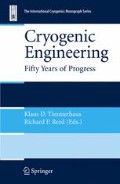Abstract
During the past 50 years, the use of digital computers has significantly influenced the design and analysis of cryogenic systems. At the time when the first Cryogenic Engineering Conference was held, thermodynamic data were presented in graphical or tabular form (the “steam table” format), whereas thermodynamic data for cryogenic system design is computer generated today. The thermal analysis of cryogenic systems in the 1950s involved analytical solutions, graphical solutions, and relatively simple finite-difference approaches. These approaches have been supplanted by finite-element numerical programs which readily solve complicated thermal problems that could not be solved easily using the methods of the 1950s. In distillation column design, the use of the McCabe–Thiele graphical method for determination of the number of theoretical plates has been replaced by numerical methods that allow consideration of several different components in the feed and product streams.
Access this chapter
Tax calculation will be finalised at checkout
Purchases are for personal use only
Preview
Unable to display preview. Download preview PDF.
References
Jacobs, R.B., “Long Distance Transfer of Liquefied Gases”, Advances in Cryogenic Engineering, Vol. 2, Plenum Press, New York, 1960, 303–317.
Gartling, D.K., “A Test Problem for Outflow Boundary Conditions–Flow Over a Backward-Facing Step”, International Journal for Numerical Methods in Fluids, 11, 953–967, 1990.
Scott, R.B., Cryogenic Engineering, D. van Nostrand, Princeton, NJ, 1959, pp. 262–319.
Din, F., Thermodynamic Functions of Gases, Butterworth, London, 1956.
Mann, D.B., “The Thermodynamic Properties of Helium from 3 to 300 K Between 0.5 and 100 Atmospheres”, NBS Tech. Note 154, US Government Printing Office, Washington, DC, 1962.
Dean, J.W., “A Tabulation of the Thermodynamic Properties of Normal Hydrogen from Low Temperatures to 300 K and from 1 to 100 Atmospheres”, NBS Tech. Note 120, US Government Printing Office, Washington, DC, 1962.
Strobridge, T.R., “The Thermodynamic Properties of Nitrogen from 64 to 300 K Between 0.1 and 200 Atmospheres”, NBS Tech. Note 154, US Government Printing Office, Washington, DC, 1962.
Weisend, J.G., Handbook of Cryogenic Engineering, Taylor and Francis, Philadelphia, PA, 1998, pp. 21–71.
Hohmann, C., and Patterson, W., “Cryogenic Systems as Auxiliary Power Sources for Aircraft and Missile Applications”, Advances in Cryogenic Engineering, Vol. 4, Plenum Press, New York, 1960, pp. 184–195.
McAdams, W.H., Heat Transfer, 3rd ed., McGraw-Hill, New York, 1954, pp. 19–52.
Kreith, F., Principles of Heat Transfer, 1st ed., International Textbook Co., Scranton, PA, 1958, pp. 153–168. See also Schmidt, E., Einführung in die technische Thermodynamik (Introduction to Engineering Thermodynamics), Springer-Verlag, Berlin, 1936, p. 262. English translation, Keston, J., Thermodynamics, Oxford University Press, New York, 1949.
Kreith, F., and Bohn, M.S., Principles of Heat Transfer, 5th ed., West Publishing, St Paul, MN, 1993.
Barron, R.F., Cryogenic Heat Transfer, Taylor and Francis., Boca Raton, FL, 1999, p. 2.
Moaveni, S., Finite Element Analysis, Prentice-Hall, Upper Saddle River, NJ, 1999.
Reddy, J.N., and Gartling, D.K., The Finite Element Method in Heat Transfer and Fluid Dynamics, 2nd ed., CRC Press, Boca Raton, FL, 2000, pp. 45–48.
Kropschot, R.H., Knight, B.L., and Timmerhaus, K.D., “Thermal Diffusivity of Powder Insulation”, Advances in Cryogenic Engineering, Vol. 14, Plenum Press, New York, 1969, pp. 224–229
Schneider, P.J., Conduction Heat Transfer, Addison-Wesley, Reading, MA, 1955, pp. 318–361.
Kayan, C.F., and Gates, R.G., “Performance Prediction of Low Temperature Air-Cooling Extended Surface by Several Comparative Methods”, Advances in Cryogenic Engineering, Vol. 3, Plenum Press, New York, 1960, pp. 325–341.
Newton, P.J., Yan, Y., Stevens, N.E., Evatt, S.T., Lock, G.D., and Owen, J.M., “Transient Heat Transfer Measurements Using Thermochromic Liquid Crystal”, Int. J. Heat and Fluid Flow, 24, 14–22, 1981.
Ruhemann, M., The Separation of Gases, 2nd ed., Oxford University Press, London, 1949, pp. 146-162.
McCabe, W.L., and Thiele, E.W., Ind. Engr. Chem., 17, 605, 1925.
Barron, R.F., Cryogenic Systems, 2nd ed., Oxford University Press, New York, 1985, pp. 179–184.
Wooley, H.W., Scott, R.B., and Brickwedde, F.G., J. Res. Nat. Bur. Standards, 41, 379, 1948.
Tong, L.S., and London, A.L., “Heat Transfer and Flow Friction Characteristics of Woven-Screen and Crossed-Rod Matrices”, Transactions of ASME, 79, 1558–1570, 1957.
Yarbrough, A.S., Flake, B.A., and Razani, A., “Computational Fluid Dynamic Modeling of Pressure Drop Through Wire Mesh Screen Regenerators”, Advances in Cryogenic Engineering, Vol. 49, American Institute of Physics, Melville, NY, 2004, pp. 1138–1145.
Kays, W.M., and London, A.L., Compact Heat Exchangers, 2nd ed., McGraw-Hill, New York, 1964.
Joshi, H.M., and Webb, R.L., “Prediction of Heat Transfer and Friction in the Offset Strip Fin Array”, International Journal of Heat and Mass Transfer, 30, 69–84, 1987.
Maiti, D., and Sarangi, S., “Fluid Flow and Heat Transfer in Offset Strip-Fin Heat Exchangers”, Proceedings of the 18th International Cryogenic Engineering Conference, Narosa Publishing House, New Delhi, India, 2000, pp. 291–294.
Author information
Authors and Affiliations
Editor information
Editors and Affiliations
Rights and permissions
Copyright information
© 2007 Springer
About this chapter
Cite this chapter
Barron, R. (2007). Advances in Cryogenic Principles. In: Timmerhaus, K.D., Reed, R.P. (eds) Cryogenic Engineering. International Cryogenics Monograph Series. Springer, New York, NY. https://doi.org/10.1007/0-387-46896-X_5
Download citation
DOI: https://doi.org/10.1007/0-387-46896-X_5
Publisher Name: Springer, New York, NY
Print ISBN: 978-0-387-33324-3
Online ISBN: 978-0-387-46896-9
eBook Packages: Physics and AstronomyPhysics and Astronomy (R0)

